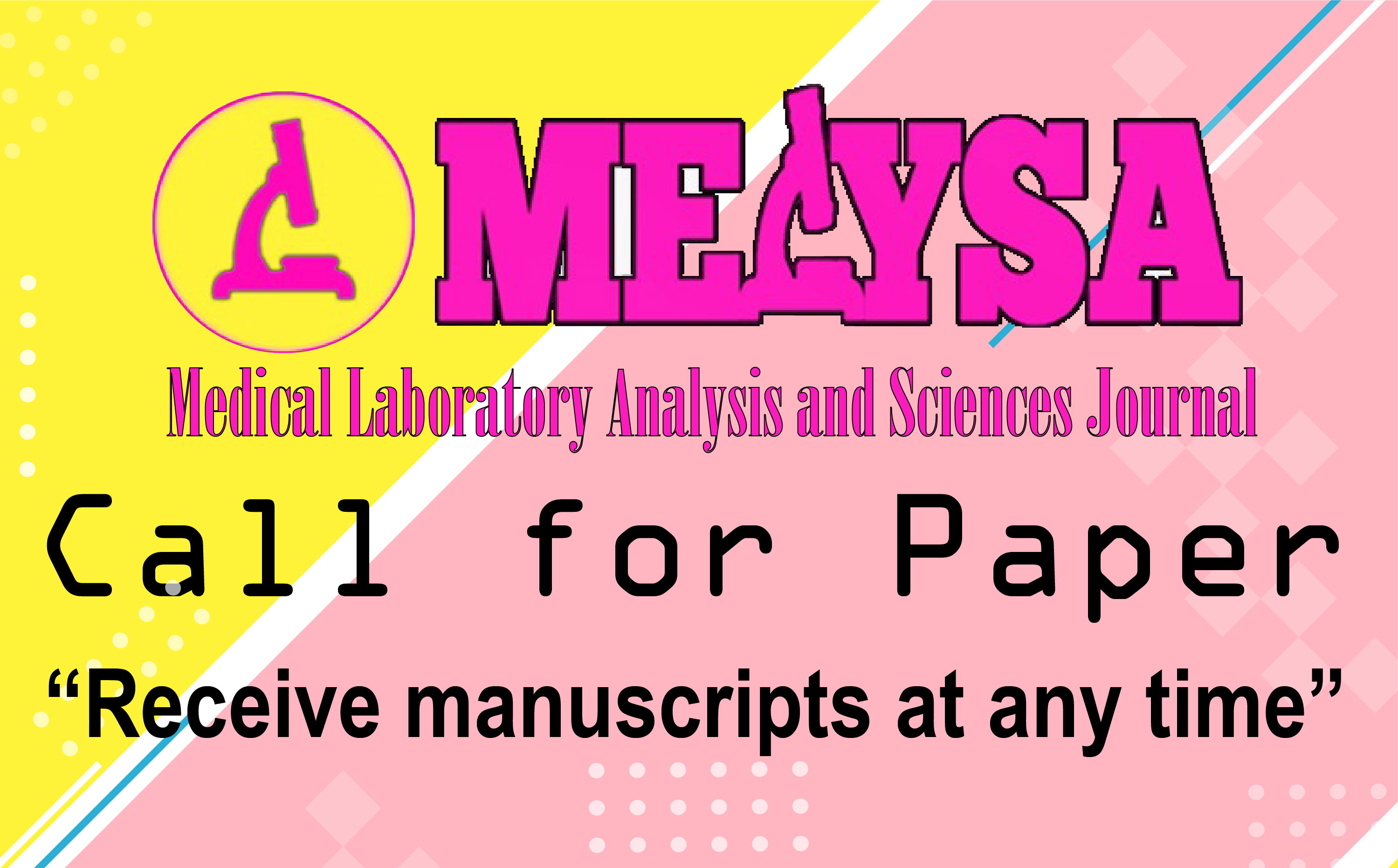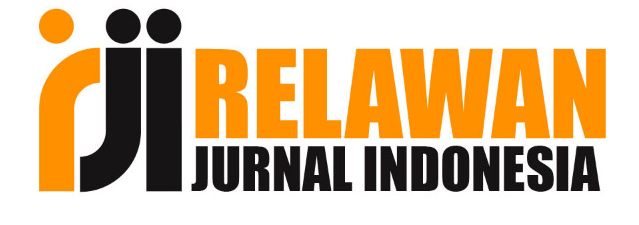ARTICLE TEMPLATE
Author Guideline
The Medical Laboratory Analysis and Sciences Journal accepts the sciences of medical laboratory areas research manuscripts which have not been published and are not currently in the process of scientific publication elsewhere. The manuscript texts are written in English. Manuscripts in English will be first reviewed by editorial boards. The main text of a manuscript must be submitted as a Word document (.doc) file.
The manuscript well-typed in a single column on A4 size paper, use 11 pt of Arial. The manuscript contains an original work and has potentially contributed to the highly scientific advancement.
The manuscript should contain the following section in order:
a. Title
Title of articles in English should describe the main content of manuscripts, be informative, concise, and not too wordy (12-14 words only), and does not contain formulas. The title describes the conducted research, Arial, Font size 14, single line spacing, 0 pt after spacing.
b. The author name
Full name without academic degrees and titles, written in capital letters. Manuscript written by groups needs to supplemented by complete contact details.
c. Name of affiliation for each author
The author's name should be accompanied by a complete affiliation address and corresponding email.
d. Abstract
Abstract, which comprised of approximately 150 until 250 words, provides a brief description of research problems, aims, the method used, and results. It emphasizes research results in which written in single line spacing with left and right margin, 3 to 5 keywords must be written to describe the research scope observed as well as the main terms undergirding the research. These keywords can be single and/or combined words.
Keywords: Written in English 3-5 words or groups of words, written alphabetically.
e. Introduction
This section could also provide the expected results. The introduction must be written in single line spacing. The introduction comprises of: (1) research problem; (2) insight and problem solve planning; (3) summary of theoretical studies and the results of the present study (state of the art), related to the observed problems (gap), and (4) research aims.
The introduction section comprises the first portion of the manuscript, and it should be written using the simple present tense. Additionally, abbreviations and explanations are included in this section. The main goal of the introduction is to convey basic information to the readers without obligating them to investigate previous publications and to provide clues as to the results of the present study (references should be selected from updated publication with a higher impact factor, traceable, and prestigious sourcebooks). To do this, the subject of the article should be thoroughly reviewed, and the aim of the study should be clearly stated immediately after discussing the basic references.
The Introduction section should consist of:
General background of research (tips: keep a maximum of one paragraph);
State of the art or a brief study of other similar (previously) research literature to justify novelty research in this article (tips: one to two paragraphs);
The reference libraries in the previous state of the art research section must be current, relevant, and original (primary literature) of the literature review not too extensive;
Gap analysis or novelty gap based on state of the art (the gap statement should contain two elements, that is, from the important aspect of the research and what the uniqueness or novelty of the research is compared to previous research);
Hypotheses (if any) are not always expressed and need not be in the form of a sentence.
Writing in the introduction by using 1 space and left-right and indent of 6 taps. Citation writing and bibliography must use a Mendeley reference manager with AMA style.
The body articles must be written in Arial Narrow, font size 11, 0 pt before spacing, and 0 pt after spacing.
f. Methods
Basically, this section describes the way the research was done. The main materials must be written here: (1) research design; (2) population and samples; (3) sample collection techniques and instrumental development; (4) data analysis techniques.
The specification and type of tools and materials must be written in case the researches have been conducted by using them. All quantities of the material are written in standard and consistent units; if the use of chemicals is specifically stated so that other researchers can replicate correctly and equipped with purity and brand, written in pure or precursor, not in solution (eg H2SO4(99%, MERCK), not like this: H2SO4 1 N ). At the time of writing the new procedure is written in the diluted form and the amount, eg: ".... dissolved in 100 ml of H2SO4 1 N. "The written research equipment is the only major set of equipment, while the small supporting equipment does not need to be written down. Each step is declared, including the number of repetitions; all techniques/ procedures stated (call the name if bakuan, or description if the procedure is new or modified), avoid the form of command sentence in outlining the procedure; it is not good to write "This research is descriptive research ..." or "This research is experimental research ...."; tools such as scissors, measuring cylinders, pencils, do not need to be written, but only write down the main set of equipment, elaborate analytical tools (even to the type and accuracy), write down the full location of the study, the number of respondents, how to process the observations or interviews or questionnaires, how to measure performance benchmarks; common methods do not need to be written in detail, but simply refer to the reference book.
g. Results and Discussion
This section is the main part of the research result article in which the �fix� results are served. The data analysis processes, such as statistical computing and hypothesis testing, are not necessary to be served. The materials reported are the analysis results and hypothesis testing results. In addition, tables and graphics are also can be showed to enunciate the verbal narration. Tables and images must be given comment or discussion.
The discussion of article aims to: (1) answer the problems and research questions; (2) show the ways the findings obtained; (3) interpret the findings; (4) relate the finding results to the settled-knowledge structure; (5) bring up new theories or modify the existing theories.
Research results must be clearly concluded in answering the research questions. Interpretting the findings should be done by using logic and present theories. The findings in the form of facts found in the research fields are integrated into previous researches or present theories. This must be supported by reliable references. In case the researchers bring new theories, the old theories can be confirmed or rejected, or modify the old theories. Result and discussion also must be the following:
- Reflected by the author's intellect?
- Author argumentation?
- How does the author relate to the opinion or other research results?
- How to relate between the results obtained and the basic concepts and or hypotheses?
- Are there any implications of both theoretical and implementation results?
- Useful authors' interpretation?
- Are there limitations of findings?
- Is there excessive speculation?
In some cases, it is unavoidable to organize an article by making sub-headings. Thus, this is the format to write Melysa manuscripts with sub-headings. In this section, there are specific rules which cannot be separated in an article.
h. Conclusion
Conclusions are made short with no numbering, conclusions simply answer the objectives or hypotheses in the study. Conclusions are written critically, meticulously, logically and honestly on the basis of the facts obtained. There should be no more discussion in conclusions and consist of only one paragraph. If there is any suggestion in conclusion, then the suggestion becomes one with the conclusion (no need to create a new sub-chapter) by simply creating a new paragraph after the conclusion paragraph. Suggestions should be in accordance with the research implications and not ridiculous.
i. Acknowledgment
Acknowledgments are conveyed to appropriate parties, especially to the institution or person who is actually assisting the research, for example: to the donor, facilities, materials or advice. The acknowledgment must be written in brief and clear. In addition, avoid hyperbole acknowledgment. Don�t give thanks to one of the authors.
j. References
Citation and referencing must be written based on American Medical Association (AMA) style which is organized by using Mendeley software's latest version (See Mendeley User Guidelines). All references in the manuscript should be written down arranged based on the order mentioned. The main bibliography is derived from books, journals, and proceedings. The minimum literature used in the manuscript is within the span of 5 years when the research is conducted. References should contain reference libraries derived from primary sources (scientific journals) of at least 80% of the total existing bibliography. Each manuscript contains at least 20 (twenty) lists of primary reference libraries. References from journal publication should be provided by DOI. For example:
- Gomes Boriollo MF, Francisco M, Netto R, et al. Performance evaluation of oxacillin-resistant Staphylococcus aureus genotypes and taxa on human and animal blood agar culture media. African J Microbiol Res. 2017;11(21):860-887. doi:10.5897/AJMR2016.8129
- Emanuel Goldman LHG. Practical Handbook of Microbiology. Third. New York: CRC Press; 2009.
- Nina Herlina, Fifi Afiati, Aditia Dwi Cahyo, Poppy Dwie Herdiyani, Qurotunnada BT. Isolasi dan identifikasi Staphylococcus aureus dari susu mastitis subklinis di Tasikmalaya, Jawa Barat. In: Pros Sem Nas Masy Biodiv Indon. Vol 1. ; 2015:413-417. doi:10.13057/psnmbi/m010305










